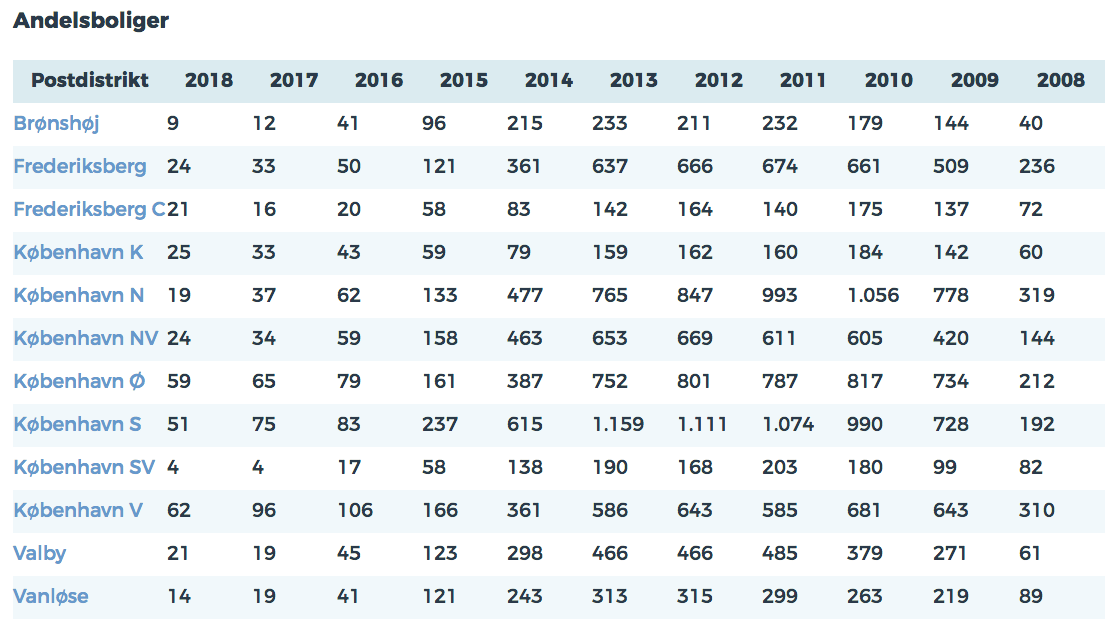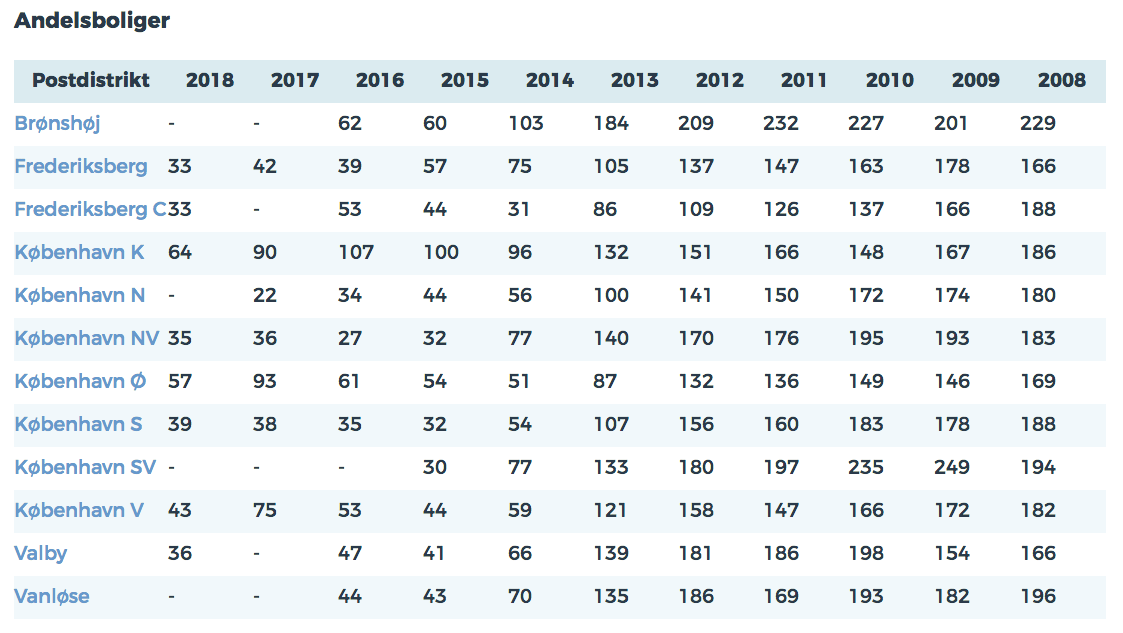Det laveste udbud af andelsboliger i 10 år
Danmark er støvsuget for andelsboliger, og når de endelig sættes til salg går det hurtigere end aldrig før at få dem afsat. Nye tal fra Boliga viser, at udbuddet af andelsboliger har nået et nyt lavpunkt, hvis man ser på udviklingen over de seneste 10 år. Faktisk er blot 333 andelsboliger sat til salg i år i Hovedstadsområdet.

Hvis du drømmer om at udleve andelstanken i en af landets andelsboligforeninger, eller blot søger at komme ind på boligmarkedet uden at skulle betale prisen for en ejerbolig, så er udsigterne ikke de bedste. Boliga har nemlig opgjort antallet af andelsboliger udbudt til salg til offentligheden over de seneste 10 år, og det viser sig, at 2018 er året med det laveste udbud. Vi ser nærmere på tallene her.
Nu er der også stor efterspørgsel på andelsboliger uden for storbyen
Så få andelsboliger sættes til salg
Ser man nærmere på tallene fra Boligas undersøgelse, spores et drastisk fald i antallet af offentlige andelsboligsalg. Sammenlignes en halvårlig periode i år med samme periode i 2013, så er der sat hele 9853 færre andelsboliger til salg. I 2013 lød det offentlige andelsboligsalg nemlig på 12.569 andelsboliger, mens tallet i år er nede på 2.716. Ser man kun et år tilbage blev der i 2017 sat 3.161 andelsboliger offentligt til salg.
Særligt i Hovedstaden er der støvsuget for andelsboliger. Her blev 333 andelsboliger sat til offentligt salg i år, og det er lige knap 6.000 færre end i 2012.
Du skal slå hurtigt til, hvis du ønsker en andelsbolig
Det er ikke kun svært at skaffe en andelsbolig, det handler også om at slå hurtigt til, når andelsboligen endelig er der. 118 dage nåede en andelsbolig på landsplan nemlig at være til salg i år, mens det sidste år var 180 dage og 261 dage i 2012. Det betyder, at andelsboligerne ikke er længe på markedet. Hurtigst sælges andelsboligerne på Frederiksberg, hvor de i gennemsnit kun befinder sig 33 dage på boligmarkedet.
Den rivende efterspørgsel på andelsboliger i særligt storbyerne betyder også, at flere andelshavere dropper ejendomsmægleren og sælger boligen selv. Samtidig benytter flere andelsboligforeninger interne ventelister til salget, ellers finder andelshavere købere gennem deres netværk. En tendens, som skyldes andelsboligmarkedet popularitet og de mange købere, der står klar til at investere i en eftertragtet andelsbolig.
Cheføkonom: Forvent at efterspørgslen fortsætter
Spørger man cheføkonom Christian Hilligsøe Heinig fra Reakredit Danmark, hvorfor andelsboligmarkedet er så populært skal svaret findes i prisniveauet på ejerboliger.
”Overordnet set tyder meget på, at man i øjeblikket får mere bolig for pengene på særligt det københavnske andelsboligmarked sammenlignet med ejerboligmarkedet i København. Det er en naturlig konsekvens af de senere års kraftige prisstigninger på ejerboligmarkedet, mens mange andelsboliger er bundet af maksimalpriser,” siger Christian Hilligsøe Heinig til BT.
Og den stigende efterspørgsel på andelsboliger vil ikke stagnere i fremtiden, hvis man spørger cheføkonomen. Han forventer nemlig, at det økonomiske opsving vil fortsætte:
”Det vil bevirke, at der stadig over det kommende års tid vil være stor rift om mange andelsboliger, og at de primært vil blive solgt uden om en ejendomsmægler,” siger han.
Læs også: Andelshavere dropper mægler og sælger boligen selv




2 kommentarer
Kan/vil i svare mig på flg: jeg købte en andelslejlighed, betalte kontant og lejer den ud…det samme året efter, så nu har jeg 2 andelslejligheder som jeg lejer ud…nu er der en mere til salg som jeg vil købe og leje ud, Bestyrelsen/formanden siger nej…kan de bestemme det ? og kan det ændres i vedtægterne… på en generalforsamling…og hvad siger de”Nye” regler…det kan tilføjes at Ejendommen/andelsboligforeningen er startet/bygget i 1983.
med venlig hilsen Torben Mortensen.
Hej Torben
Tak for din henvendelse. Det er ret almindeligt, at andelsboligforeninger har vedtægtsbestemt bopælspligt i andelsboligerne. Det betyder, at hvis man køber boligen, så skal man også selv bo der. Hvis andelsboligforeningen ønsker at ændre sine vedtægter, så er det muligt, hvis flertallet er bag. Du kan læse mere om, hvordan vedtægterne ændres i denne guide: https://www.andelsportal.dk/guides/vedtaegtsaendringer/
Bedste hilsner
/Nynne – Andelsportal.dk
Viser 0 af 2 kommentarer